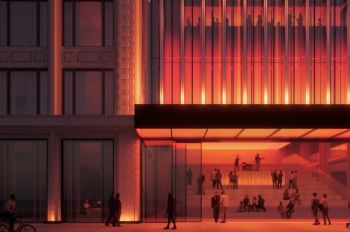Architecture Students to Push Englewood Development to Critical Mass

A collaboration of Illinois Institute of Technology College of Architecture students, a local developer, and a Chicago alderman is aimed at contributing to the continued efforts of Chicago’s Englewood neighborhood to build a strong future.
A unique plan to build attractive and affordable homes for middle-income families started to take shape when project client and Englewood-raised Kenny Smith, CEO of the nonprofit Wholistic Community Development Association, walked into S. R. Crown Hall last year and asked for help designing homes for a new project to reinvigorate the neighborhood.
The project grew to include Alderman Stephanie Coleman (16th Ward), whose district includes her home community of Englewood, and a dozen students in a fifth-year studio led by Adjunct Professor Steven Pantazis. The group met in Crown Hall at the beginning of the spring semester, where Smith and Coleman outlined their plan: to build imaginative homes for residents who want to stay in the neighborhood.
“It’s not that folks don’t make enough to live in nice housing,” Coleman says. “The stock just isn’t there. The same people want to live in clean, modern, and efficient homes.”
Houses or classic Chicago two-flats are slated to be built on more than 20 empty lots southwest of the intersection of South Halsted and West 63rd streets. Englewood Connect, a $13.9 million development project under the city’s INVEST South/West initiative, will sit across the street from the new houses and is expected to become a culinary and business hub.
Families that move into the area could spark further growth. “Once we develop a community where customers are, businesses will come. There is a tipping point we need to get to,” Coleman says.
For students, the project is deceptively straightforward—design a home that the “missing middle” can afford, Pantazis says. “Speculative developers are building affordable housing for socio-economically challenged buyers, or they aim for high-end luxury. No one is targeting middle-income people. A lot are moving to the suburbs because housing isn’t available.”
Some hard restrictions, such as Chicago’s standard lot size of 25 feet by 125 feet and a square foot limit, give students a framework, but the developer has given the studio nearly free reign over design, Pantazis says. Some developers shy away from using the most modern technology available, but Smith says he wants to see students flex their creative muscles.
The students are all working toward a stronger Englewood, but there is a competition of sorts. The first home built as part of the project will be based on a student design, which is an opportunity rarely afforded to students—seeing their schematics become reality. “The studio is somewhat unique for an architecture school,” Pantazis says. “It’s an opportunity for students to work with a real client with the potential of seeing their designs built.”
Photo: A student rendering of what a home could look like in Chicago’s Englewood neighborhood [provided by John Mulvey (ARCH 5th Year)]




